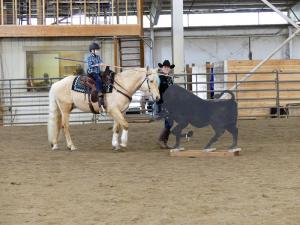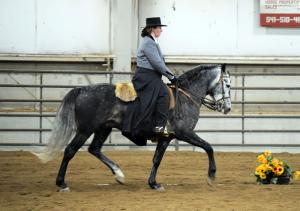By Jody Fontanetta and Julie Alonzo; photos by Diana Inch
Working Equitation is a relative new-comer to equestrian sports, combining the precision of dressage, the partnership of trail classes, the adrenaline rush of timed events, and the working traditions of cattle handling. The basis for Working Equitation is rooted in the classical training required to develop a working ranch horse on the Iberian Peninsula. The sport originated in four countries: Italy, Portugal, Spain, and France. The first International competition for this sport was held in 1996.
In the United States, there are seven performance levels: Introductory, Novice A, Novice B, Intermediate A, Intermediate B, Advanced, and Masters. Competition consists of three phases for individual trials and four phases for team trials. The first phase of competition is a dressage test ridden in a 20 x 40 meter court. Each level has its own pattern, developed by the governing body, and is distinct from those developed by the United States Dressage Federation. The movements are designed to illustrate the increasingly greater expectations of horse and rider as they progress from rudimentary riding skills through the more advanced equestrian abilities.
The Introductory level dressage requires simple movements, such as walking and trotting straight lines and circles, making it a safe place for beginner riders and horses to the sport. As the levels progress, the difficulty of dressage movements increases, culminating at the highest levels with lateral movements, extensions and collections at trot and canter, canter pirouettes, and flying lead changes.
The Advanced level requires the dressage movements to be completed with only one hand on the reins, regardless of type of bit and bridle used. At the Master’s level, one-handed riding is still required, but riders add an artistic element by choreographing their own musical freestyle.
Working Equitation uses a scoring system similar to that in traditional dressage. The judge scores each movement on a scale of 0-10, and provides “Collective Marks” at the conclusion of the test for gaits, impulsion, submission, and rider’s aides, and presentation.
Ease of handling (EOH) is the second phase, where competitors demonstrate their ability to successfully negotiate a variety of ordered obstacles with finesse and harmony. The expectations outlined in each level’s Dressage tests carry over into the EOH trial. Judges evaluate the performance based on the quality of bend and symmetry; the straightness, balance, and immobility at halt; the quality with which they perform rein-back; and the horse’s overall submission, impulsion, and quality of gaits. Introductory level competitors are required to walk or trot the course, and the obstacles presented do not require lateral movement or jumping. Canter is introduced at the Novice level. The course must be completed one-handed at the Advanced and Masters level. The scoring is identical to the dressage trial, including “Collective Marks” at the conclusion with the judge scoring each obstacle performed on the EOH course on a scale of 0-10.
For the next phase, riders in Novice A and above move on to a numbered obstacle course that is timed. There are no scores for performance – the fastest time to complete the course wins the phase. Riders may receive bonus time or penalties during the speed phase. For example, skewering the ring with the garrocha pole earns 10 seconds subtracted from the final time, while knocking over an obstacle may add 10 seconds to the time.
In some team competitions, riders may enter the timed Cow Trial, in which they work with 3-4 teammates to cut a designated cow from a herd and move it into a holding pen on the other side of the arena. Unlike the Dressage and Ease of Handling trials, the Speed and Cow trials are scored by time, rather than judged.
Each of the trials demands different skills from horses and riders, yet they are all connected by the overall goal of solid horsemanship. Many people associate the sport of Working Equitation with the Iberian breeds, chiefly the Lusitano and Andalusian; but there are more American Quarter Horses and grade horses competing in the sport in the U.S. Gaited horses are welcome to participate, with the same expectations for performance applied, and “intermediate gait” judged in place of trot.
The all-encompassing focus of the sport is on the fundamentals - building strong horsemanship and developing a harmonious partnership between horse and rider. If a horse can halt, walk, and trot (or gait), it can meet the basic requirements to participate in the sport.
To learn more, visit www.WEUnited.us. An Educational Symposium is being planned for 2021, highlighting sessions with António Vicente, a highly-respected International Level Working Equitation judge and University professor from Portugal.
Upcoming Events in the Southeast:
September 12-13: Working Equitation Clinic and Schooling Show at Wild at Heart Ranch, Canton, GA. Info at www.facebook.com/WorkingEquitationGeorgiaLLC
October 9-11: Working Equitation by the River Clinic and Rated Show at River Glen Equestrian Park, New Market, TN. Info at www.river-glen.com
October 23-25: Working Equitation Camp and Schooling Show at Fairfield Farms, Milton, TN. Email: fairfieldfarmstn@yahoo.com
Photo credits: Diana Inch
Photo cutlines:
Brenda Quick riding Della D Salute, Palomino Quarter Horse, over the jump obstacle
Howard Peet riding CDC Corazon, Andalusian, in Dressage
TeiganBilyeu riding Canadian Horse, MetistarTaj-MahalAmaro, with the spear ring obstacle
Rochelle O’Connor riding CDC VaPorTi, Andalusian, in Dressage
Kristina Amaro riding a Canadian Horse through the gate obstacle
Working Equitation is a relative new-comer to equestrian sports, combining the precision of dressage, the partnership of trail classes, the adrenaline rush of timed events, and the working traditions of cattle handling. The basis for Working Equitation is rooted in the classical training required to develop a working ranch horse on the Iberian Peninsula. The sport originated in four countries: Italy, Portugal, Spain, and France. The first International competition for this sport was held in 1996.
In the United States, there are seven performance levels: Introductory, Novice A, Novice B, Intermediate A, Intermediate B, Advanced, and Masters. Competition consists of three phases for individual trials and four phases for team trials. The first phase of competition is a dressage test ridden in a 20 x 40 meter court. Each level has its own pattern, developed by the governing body, and is distinct from those developed by the United States Dressage Federation. The movements are designed to illustrate the increasingly greater expectations of horse and rider as they progress from rudimentary riding skills through the more advanced equestrian abilities.
The Introductory level dressage requires simple movements, such as walking and trotting straight lines and circles, making it a safe place for beginner riders and horses to the sport. As the levels progress, the difficulty of dressage movements increases, culminating at the highest levels with lateral movements, extensions and collections at trot and canter, canter pirouettes, and flying lead changes.
The Advanced level requires the dressage movements to be completed with only one hand on the reins, regardless of type of bit and bridle used. At the Master’s level, one-handed riding is still required, but riders add an artistic element by choreographing their own musical freestyle.
Working Equitation uses a scoring system similar to that in traditional dressage. The judge scores each movement on a scale of 0-10, and provides “Collective Marks” at the conclusion of the test for gaits, impulsion, submission, and rider’s aides, and presentation.
Ease of handling (EOH) is the second phase, where competitors demonstrate their ability to successfully negotiate a variety of ordered obstacles with finesse and harmony. The expectations outlined in each level’s Dressage tests carry over into the EOH trial. Judges evaluate the performance based on the quality of bend and symmetry; the straightness, balance, and immobility at halt; the quality with which they perform rein-back; and the horse’s overall submission, impulsion, and quality of gaits. Introductory level competitors are required to walk or trot the course, and the obstacles presented do not require lateral movement or jumping. Canter is introduced at the Novice level. The course must be completed one-handed at the Advanced and Masters level. The scoring is identical to the dressage trial, including “Collective Marks” at the conclusion with the judge scoring each obstacle performed on the EOH course on a scale of 0-10.
For the next phase, riders in Novice A and above move on to a numbered obstacle course that is timed. There are no scores for performance – the fastest time to complete the course wins the phase. Riders may receive bonus time or penalties during the speed phase. For example, skewering the ring with the garrocha pole earns 10 seconds subtracted from the final time, while knocking over an obstacle may add 10 seconds to the time.
In some team competitions, riders may enter the timed Cow Trial, in which they work with 3-4 teammates to cut a designated cow from a herd and move it into a holding pen on the other side of the arena. Unlike the Dressage and Ease of Handling trials, the Speed and Cow trials are scored by time, rather than judged.
Each of the trials demands different skills from horses and riders, yet they are all connected by the overall goal of solid horsemanship. Many people associate the sport of Working Equitation with the Iberian breeds, chiefly the Lusitano and Andalusian; but there are more American Quarter Horses and grade horses competing in the sport in the U.S. Gaited horses are welcome to participate, with the same expectations for performance applied, and “intermediate gait” judged in place of trot.
The all-encompassing focus of the sport is on the fundamentals - building strong horsemanship and developing a harmonious partnership between horse and rider. If a horse can halt, walk, and trot (or gait), it can meet the basic requirements to participate in the sport.
To learn more, visit www.WEUnited.us. An Educational Symposium is being planned for 2021, highlighting sessions with António Vicente, a highly-respected International Level Working Equitation judge and University professor from Portugal.
Upcoming Events in the Southeast:
September 12-13: Working Equitation Clinic and Schooling Show at Wild at Heart Ranch, Canton, GA. Info at www.facebook.com/WorkingEquitationGeorgiaLLC
October 9-11: Working Equitation by the River Clinic and Rated Show at River Glen Equestrian Park, New Market, TN. Info at www.river-glen.com
October 23-25: Working Equitation Camp and Schooling Show at Fairfield Farms, Milton, TN. Email: fairfieldfarmstn@yahoo.com
Photo credits: Diana Inch
Photo cutlines:
Brenda Quick riding Della D Salute, Palomino Quarter Horse, over the jump obstacle
Howard Peet riding CDC Corazon, Andalusian, in Dressage
TeiganBilyeu riding Canadian Horse, MetistarTaj-MahalAmaro, with the spear ring obstacle
Rochelle O’Connor riding CDC VaPorTi, Andalusian, in Dressage
Kristina Amaro riding a Canadian Horse through the gate obstacle













